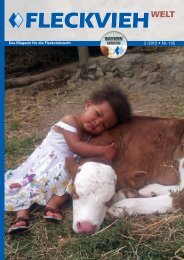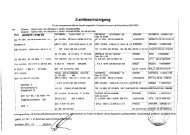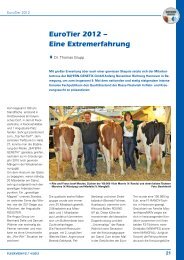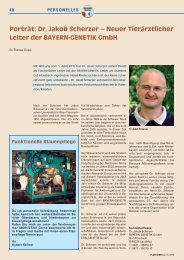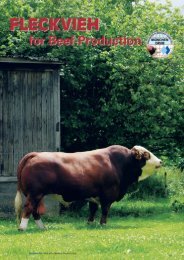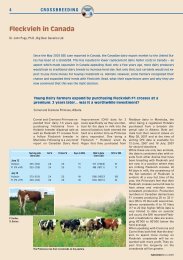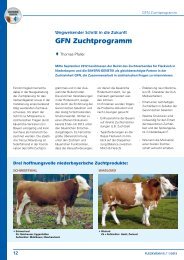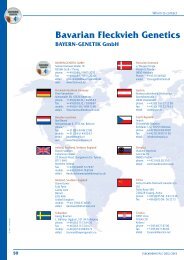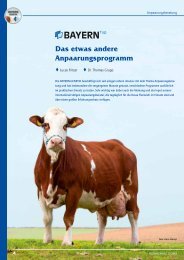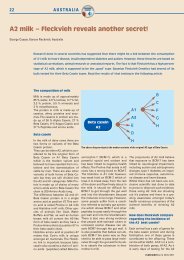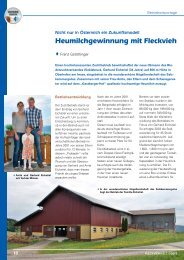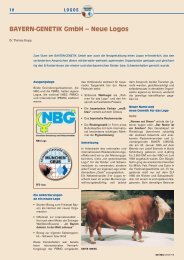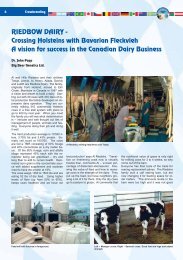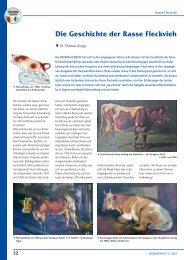Create successful ePaper yourself
Turn your PDF publications into a flip-book with our unique Google optimized e-Paper software.
<strong>Fleckvieh</strong>-<strong>Vision</strong><br />
Dr. Thomas Grupp<br />
I. <strong>Fleckvieh</strong> becomes the most important cattle breed for<br />
pure- and crossbreeding<br />
II. Crossings between <strong>Fleckvieh</strong> and dairy breeds will have a<br />
share of 50% among all cattle in Europe in future to<br />
exploit the advantages of heterosis and to improve the<br />
secondary traits<br />
III. Without a dual purpose breed economically effective dairy<br />
farming will be possible only in a very limited way in the<br />
future<br />
IV. <strong>Fleckvieh</strong> is the only cattle breed that enables the farmers<br />
to meet the high demands on milk hygiene<br />
V. The technical progress in the stable and last but not least<br />
the introduction of milking robots and standardized<br />
feeding systems (TMR) favours <strong>Fleckvieh</strong> very much<br />
VI. An economically successful suckler cow production will<br />
be possible only in few places in the future and commer<br />
cial beef herds will have a high percentage of <strong>Fleckvieh</strong>blood<br />
VII. Payment according to the quality of the carcass gets more<br />
important. Good qualities will be paid high, bad qualities<br />
are hard to sell<br />
VIII. <strong>Fleckvieh</strong> offers family farms a chance to survive<br />
IX. <strong>Fleckvieh</strong> and <strong>Fleckvieh</strong>-crossings correspond with the<br />
demands of the consumers for a balanced animal that<br />
does not go for the extremes<br />
X. Bavarian <strong>Fleckvieh</strong> Genetics owns the breeding nucleus of<br />
a global breed with extraordinary potential - <strong>Fleckvieh</strong><br />
Take a share of our superior genetics!
„Traudi“, V: ZEUS<br />
„Traube“, daughter of Traudi, V: STRESS<br />
„Trapez“, daughter of Traube S: RENOLD<br />
➡ ➡<br />
<strong>Fleckvieh</strong> breed 5<br />
„What is <strong>Fleckvieh</strong>?“<br />
Dr. Thomas Grupp<br />
Many breeders I talked to repeatedly<br />
asked me the same question: „What is<br />
<strong>Fleckvieh</strong>?” „Is Montbeliard just another<br />
name for <strong>Fleckvieh</strong>?” „Why is Simmental<br />
different to <strong>Fleckvieh</strong>?” „Can you tell me<br />
what <strong>Fleckvieh</strong> exactly is?”<br />
In order to explain the difference between<br />
<strong>Fleckvieh</strong> and other Simmental influenced<br />
breeds to you I would first like to give you a<br />
short historic review on how <strong>Fleckvieh</strong> developed<br />
in the Southern part of Germany.<br />
Starting in 1830 original Simmental cattle<br />
from Switzerland were imported to the Bavarian<br />
Kingdom and to former Austria. The<br />
Simmental cattle were famous for their performance<br />
in milk and labour. These imports<br />
were used to improve local breeds which<br />
were all kept for dual or triple purpose. Beginning<br />
in the 1920ies after the First World<br />
War the economic change took place in<br />
cattle breeding. In Southern Germany the<br />
breeding aims were focused on a „middle<br />
of the road type” animal with excellent<br />
muscling and good milk performance. The<br />
original Simmental cow was late maturing<br />
with less depth and coarse bones. From<br />
this time the herdbook was more or less<br />
closed. Some Swiss original bulls which<br />
express the <strong>Fleckvieh</strong> type were tested in<br />
the 60ties and the 70ties and also some<br />
Montbeliard bulls but their influence can be<br />
neglected. To improve the udders and the<br />
milk performance a scientific trial was started<br />
in the 70ties. The 50% Red Holstein<br />
bull Redad from Switzerland was introduced<br />
into the <strong>Fleckvieh</strong> population. His progeny<br />
did very well. He improved not only<br />
the udder quality but also milk and to some<br />
extend beef performance. Today 79% of<br />
the <strong>Fleckvieh</strong> population has no foreign<br />
blood. 18,5% of the <strong>Fleckvieh</strong> cows carry<br />
up to 6% foreign genes and 2% carry 6-<br />
12%. The average blood percentage of other<br />
breeds was 1,63% in the year 2000 in<br />
<strong>Fleckvieh</strong> the whole <strong>Fleckvieh</strong> population<br />
compared to 0.86% in 1982.<br />
Many breeds have the same colour like<br />
<strong>Fleckvieh</strong> cattle but they are of a different<br />
type. The type is unique among <strong>Fleckvieh</strong><br />
worldwide.<br />
The type of <strong>Fleckvieh</strong> we are breeding for<br />
is comparable to<br />
● Austrian <strong>Fleckvieh</strong><br />
● South African Simmentalers<br />
● Simmental Français<br />
● Razza Pezzata Rossa (Italy)<br />
However the type still differs slightly even<br />
among the <strong>Fleckvieh</strong> population. Bavarian<br />
<strong>Fleckvieh</strong> Genetics favours that type of animal,<br />
described in the „Standard of excellence”<br />
published by the Simmentaler Society of<br />
Southern Africa. The only difference is, that<br />
we accept bigger animals – our breeding<br />
aim is 140 cm to 145 cm height at withers.



